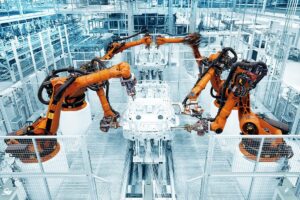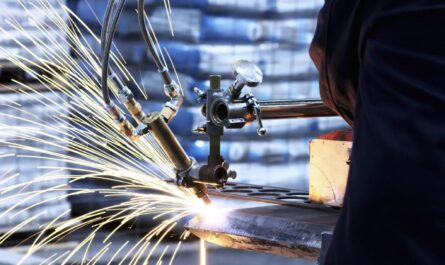
Industrial robots have become ubiquitous in manufacturing facilities across the world. Their presence on factory floors is rapidly increasing as factories look to automate more tasks for improved productivity and quality. Robots are enhancing manufacturing capabilities and allowing companies to meet rising consumer demands. This article explores how industrial robotics is transforming modern manufacturing.
Automation and Productivity Gains
One of the primary drivers for increased adoption of industrial robots has been the need for automation and productivity improvements. Automating repetitive and physically demanding tasks through robots allows companies to increase output without having to increase their workforce. Robots can work tirelessly around the clock with high precision and accuracy. They eliminate human error from production lines leading to fewer defects. This has significantly boosted productivity and quality for manufacturers.
Several studies have shown that factories using industrial robots experience productivity increases anywhere between 20-30%. Robots take over mundane and ergonomically challenging jobs like grinding, polishing, welding, assembling and packaging. This frees up human workers to take on more skilled jobs like programming, maintenance and supervision. The automation of processes through industrial robotics has been a game changer for industries like automotive, electronics, plastics and pharmaceuticals in meeting rising demand.
Impact of COVID-19 on Automation Trends
The COVID-19 pandemic has further accelerated the need for automation and use of robots. As the virus disrupted global supply chains, it highlighted vulnerabilities in production models that were heavily reliant on human workers. Manufacturers had to either shut down plants or run them with limited workforce due to lockdowns and social distancing rules. This underscored the importance of making operations less dependent on human labor through increased levels of automation using industrial robotics.
Many companies fast-tracked deployment of collaborative robots or cobots during this period to ensure business continuity. Cobots assist human workers and can work safely alongside them without compromising on social distancing protocols. The pandemic strengthened the case for robotics by demonstrating how automation technologies provide operational flexibility even during crises by minimising workforce dependencies. Going forward, industries are expected to scale up automation strategies incorporating more robots to build resilience against future disruptions.
Expanding Applications
Industrial robots were initially limited to structural repetitive tasks like welding, painting and assembly but are now capable of much broader range of applications. Advancements in robot design, artificial intelligence, vision technology and collaborative capabilities have enabled new uses beyond traditional automated functions. Robots are now assisting in complex tasks like inspection, quality control, machine tending, logistics, packaging and palletizing.
Many manufacturers are implementing mobile, collaborative and modular robots that can work flexibly across diverse tasks in an assembly line. Startups are developing new generation of low-cost lightweight robots for small and medium enterprises to automate processes like material handling, inspection and sorting. Robots with integrated vision systems can now imitate capabilities of human sight for applications like defect detection, quality checks and remote monitoring. Sophisticated cobots are collaborating safely alongside human employees to increase precision and productivity. These expanded capabilities are helping industries derive even greater value from robotics investments.
AI Integration and Smart Manufacturing
Industrial robots are increasingly relying on integration with artificial intelligence and machine vision technologies to augment their abilities. AI gives robots a new level of cognition to perceive environment, learn from data, and exhibit informed behavior. Computer vision enabled robots can now visually grasp context, recognize patterns and make independent decisions to optimize operations. AI and machine learning algorithms deployed on robots help them perform predictive maintenance, schedule tasks autonomously based on priority, and optimize energy usage.
AI brings the promise of making robots smarter, more flexible and human-friendly, even mimicking human skills and emotions. Many companies are pursuing smart manufacturing strategies based on connecting robots, machines, sensors and people on shared digital platforms enabled by AI, 5G, Internet of Things and Cloud Computing. Such smart factories aim to maximize productivity, costs and throughput, while minimizing downtime and errors through coordinated actions of automation technologies. As AI capabilities of robots continue to rise, they will multiply their positive impact on industries and redefine manufacturing landscapes.
Job Transformations and Reskilling Needs
While robots are replacing human workers for dangerous, repetitive and labor intensive jobs, they are also creating new kinds of roles for people. Factory operations now need robot programmers, interface developers, system integrators, maintenance engineers and supervisors to maximize productivity from increasing number of robots installed. Technicians proficient in mechatronics, robotics, artificial intelligence, virtual reality and other technologies will be in high demand for supporting automated production lines.
The growing presence of robots in industries has led to a massive need for reskilling and upskilling existing workforce. Workers previously engaged in eliminated jobs require retraining to take on roles like data analytics, programming, automation equipment operation, quality control and management. Vocational training providers, community colleges and universities are designing targeted programs for developing capabilities relevant to modern manufacturing environments centered around robotics and smart equipment. Overall job demand may reduce for low-skilled repetitive roles but significantly increase for those with technical and supervisory skillsets in collaborating with robots.
Conclusion
industrial robots has revolutionized manufacturing practices worldwide, driving higher productivity, quality and flexibility. Advancements in robotics, artificial intelligence, vision and digital technologies are enhancing capabilities beyond conventional applications. Their increased use delivers substantial benefits for industries in meeting aggressive benchmarks while also empowering human workers through new high-skilled roles. Automation catalyzed by robotics brings both opportunities and adjustments but will define the future of manufacturing, making it smarter, cleaner and more globally competitive. Ongoing adaptations in work processes, job profiles and reskilling will allow industries and societies to maximize positive impacts of industrial robotics revolution.
*Note:
1. Source: Coherent Market Insights, Public sources, Desk research
2. We have leveraged AI tools to mine information and compile it



